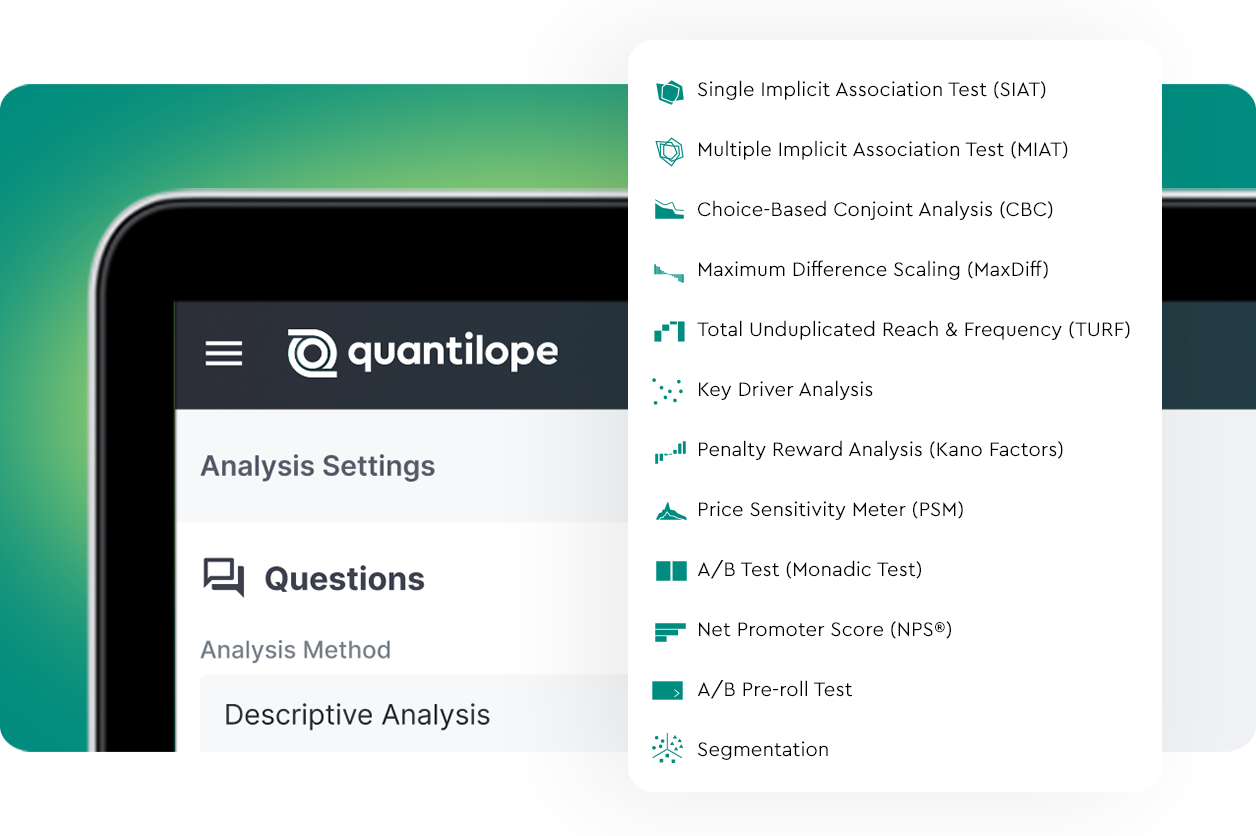Any business in a consumer-facing industry will want to capture consumer insights. This blog post explores how to capture consumer insights through market research and how to put them to the best use.
Table of Contents:
- What are consumer insights?
- Types of consumer insights
- Benefits of gathering consumer insights
- What’s the difference between consumer insights and market research?
- How to gather consumer insights
What are consumer insights?
Consumer insights are findings about how consumers think, behave, or feel. They provide a glimpse into consumers’ viewpoints and how their attitudes affect what they do (i.e. what they purchase, what they say about your brand, where they shop, etc.).
For example, if your business is a video streaming platform, a consumer insight might be that a large portion of younger demographic consumers tends to stream content between the hours of 4 pm and 6 pm (after school and before dinner). Meanwhile, older demographics stream content most frequently in the late evening, as a treat to the end of the work day and after cleaning up dinner. These basic consumer insights reveal a lot about how consumers use streaming platforms and their reasons why - which can empower your brand to make decisions accordingly.
Types of consumer insights
Consumer insights come in many forms, each offering a unique perspective on behaviors and preferences depending on the type of information a business is seeking out.
Below is a breakdown of just a few common consumer insight categories:
-
Demographic insights:
These focus on the characteristics of your target audience, such as age, gender, income, education, and geographic location. Understanding these factors helps you tailor your products and marketing messages to specific audience segments.
-
Behavioral insights:
Behavioral insights dive into how consumers interact with your brand and products. It might cover purchase history, website browsing behavior, social media engagement, and customer service interactions. Analyzing this type of consumer data reveals patterns that inform new product development and marketing strategies.
-
Attitudinal insights:
These insights uncover the underlying attitudes and opinions behind consumer actions. It involves understanding consumers' inherent values, beliefs, and perceptions of your brand. Given the nature of these insights, brands often opt to use implicit methodologies (like SIAT and MIAT) to capture subconscious reactions. Examples of these insights could be things like if consumers are environmentally friendly, value conscious, premium seekers, etc.
-
Motivational insights:
This category of consumer insights aims to understand the deeper reasons why consumers make specific choices. It explores their needs, desires, and pain points. Uncovering these motivations allows you to position your products as solutions and build stronger emotional connections with your audience. One way of doing this is using advanced methodologies - like a MaxDiff to prioritize long list items rather than being left with an 'everything is important' fallacy.
-
Competitive insights:
Analyzing your competitors' customer data and marketing strategies can often yield valuable insights into industry trends and consumer preferences. This information can guide your own decision-making and help you uniquely differentiate your brand. You can capture these type of insights by including competitive brands in your research study to compare how metrics stack up for each. An example of this would be learning if there are any unclaimed white spaces within your industry, such as specializing in 'value' and 'affordability'.
By understanding the different types of consumer insights available through research, you can choose the right approach that will provide clear recommendations and drive future business growth. And keep in mind that many consumer insights studies combine a number of the above insight types - creating the ability to cut attitudinal data by demographic information, for example.
Back to Table of Contents
Benefits of gathering consumer insights
Consumer insights can provide a solid foundation to base business decisions around. They take the guesswork out of what motivates people to buy one product rather than another, providing brands with reassurance on innovation ideas, marketing efforts, product launches, and more. Below are four specific ways brands benefit from consumer insights.
- Gain a better understanding of your buyers
Brands must be careful not to assume they know what consumers’ motivations are or how they feel about something. For example, say a brand of meats looks at sales numbers and sees consumers are buying more poultry than beef; to the brand, this may signal that consumers prefer poultry when in reality, consumers happen to be buying more of it simply because it’s cheaper than beef. Without asking for clarity from consumers, brands will base decisions on gut feel rather than data-supported insights...and potentially leave money on the table.
Understanding what really triggers consumer actions can help businesses cater their products to best fit into consumers’ lives. When it comes time for a purchase decision, consumers will take notice of the brands that pay attention to their consumer needs at each part of the customer journey.
- Improved customer lifetime value
When your target audience feels like you really understand them, they’re far more likely to remain loyal to your brand. Gaining consumer insights and using them to guide your business strategy is a dual benefit - you learn about your market, and your market feels heard.
For example, if a consumer of a facial cream finds that the packaging, branding, texture, scent, and results of their face cream are consistently excellent, they are likely to stay a loyal customer.
- Personalized customer experience
Understanding consumers doesn’t just mean understanding the group as a whole; it also includes identifying how different segments within your target audience behave and feel. Customer insights relevant to each consumer segment - whether based on demographics, attitudes, behaviors, or needs - help create targeted product development and marketing strategies that reach every type of consumer within an overall target market. Personalized customer insights can be used to create greater customer satisfaction, offer closely tailored customer support for varying needs, and ultimately increase customer retention by way of customer loyalty.
- Better ad targeting
Reflecting consumers’ values in brand messaging makes it more likely that consumers will feel the advertising and brand is relevant to them. For example, if consumers talk about wanting breath mints that are ‘refreshing,’ ‘flavorful’, or ‘non-sugary’, speaking to these elements in your ad messaging will appeal to them and catch their attention. You can target ad messaging by different segments too, including where you advertise to different types of consumers based on their behaviors and preferences (i.e. social media, TV, radio, or print messaging).
Back to Table of Contents
What’s the difference between consumer insights and market research?
While these terms can often be used interchangeably, there is a difference between market research and consumer insights.
Market research is the act of gathering consumer data - the numbers and the facts around consumer behavior, needs, and attitudes. It involves collecting quantitative and qualitative data through surveys, focus groups, interviews, and observations. Market research answers the "what" questions: What are consumers buying? What are their needs? What are their demographics?
Meanwhile, consumer insights go a step further to interpret the metrics captured through market research sources, social media, customer feedback, and so on. Consumer insights are data-driven findings/takeaways - which might be entirely new revelations or confirmations of an existing hypothesis - that explore why rather than just the what; Why do consumers choose certain products? Why are consumers loyal to a brand? Why do some consumers abandon their shopping carts?
Market research provides the foundation, while consumer insights are the actionable takeaways that guide actual business decisions.
How to gather consumer insights
Having established that consumer insights are valuable building blocks for business initiatives, let’s talk about how to go about extracting them from market research. For a widespread understanding of customer behavior, it pays to devise an insights research strategy which maps out what it is you want to learn over a period of time, where you’re going to find the information you need, how you’re going to gather that information, and what you’ll do with the collected data.
The below paragraphs highlight common and effective sources of consumer insights.
Market Research:
This is the foundation of consumer understanding. It involves collecting quantitative and qualitative data through surveys, interviews, focus groups, and observation. Market research data collection can be as broad or specific as a business needs, providing them with the opportunity to cut/split data by various target audience groups or segments of interest. Market research also allows brands to explore consumer preferences in depth through open-ended questions or qualitative focus group feedback, either of which feed into business strategy - especially for new product development and marketing initiatives.
When choosing a market research provider/platform, look for one that offers real-time access to your data to get a jump-start on decision making, has AI capabilities such as an AI co-pilot, and offers a wide array of advanced methodologies to dive beyond surface level insights; technological advances in the market research industry have made it so brands can always be closer to their own data, and tools such as these are some of the best ways to do so.
Customer service feedback:
Customer service interactions can tell a business a lot about its customers. Analyzing call transcripts, emails, chat logs, and even social media interactions can reveal common customer pain points, product issues, or satisfaction levels. This data can help your business identify areas for improvement and tailor your communication strategies based on consumer feedback.
Purchase history:
Tracking what customers buy (and when/how often they buy it) can reveal valuable patterns and trends. Analyzing purchase history data can help you identify popular products, understand seasonal fluctuations, and tailor your marketing campaigns to specific customer segments at certain points throughout the year.
Product reviews:
Customer reviews and ratings on your website or third-party platforms provide a direct line of communication with your audience. Analyzing this feedback can help you understand what customers like and dislike about your products, identify actionable areas for improvement, and build a more customer-centric brand overall. Gathering consumer insights is an ongoing process. By continuously listening to your customers and adapting to their needs, you have a better chance of remaining relevant and successful over time. By combining data from any number of these sources, you can create a comprehensive picture of your consumers to make more informed decisions, drive business growth, improve customer satisfaction, and build a more loyal customer base.
How to use consumer insights for business growth
Knowing the types of consumer insights available, the benefits in leveraging them, and how to do so, let's explore a few examples below in how a business might use consumer insights to fuel growth.
Customer service:
- Identify pain points: Analyzing customer feedback, surveys, and social media conversations can pinpoint common issues and frustrations. This enables businesses to proactively address these concerns, improve response times, and provide more effective solutions.
- Personalize interactions: Understanding individual customer preferences and purchase history allows for tailoring future interactions to specific needs. This can be achieved through personalized recommendations, targeted offers, or proactive support based on past consumer behavior.
Customer acquisition:
- Targeted marketing campaigns: Insights into consumer demographics, interests, and online behavior can help form closely-targeted advertising campaigns. This ensures that marketing efforts reach the right audience with the right message, increasing the overall chances of conversion.
- Refining value propositions: By digging into consumer insights to understand what motivates potential customers and what they value in a product or service, businesses can refine their messaging and offerings to align with customer expectations, and attract new customers more effectively.
Customer retention:
- Proactive engagement: Insights into customer churn patterns and reasons for dissatisfaction can help businesses proactively address potential issues before customers decide to leave. This might involve personalized offers, loyalty programs, or early intervention strategies.
- Loyalty program optimization: Understanding what drives customer loyalty allows for the creation of tailored reward programs that resonate with individual preferences, incentivizing repeat purchases and long-term engagement.
Customer engagement:
- Content personalization: Leveraging insights into customer interests and preferences can guide the creation of content that is more likely to capture their attention and encourage interaction. This can include personalized emails, social media posts, or blog articles tailored to individual interests. This also feeds into the above points around customer acquisition and loyalty.
- Community building: Insights into customer behavior on social media and online forums can help businesses foster a sense of community around their brand. This can be achieved through interactive campaigns, user-generated content initiatives, or exclusive online groups.
Personalized marketing:
- Tailored recommendations: By analyzing past purchase history, browsing behavior, and demographic information, businesses can recommend products or services that are most likely to appeal to individual customers, increasing the relevance and effectiveness of marketing messages.
- Dynamic pricing: Insights into customer price sensitivity and purchase patterns can enable dynamic pricing strategies, where prices are adjusted in real-time based on individual customer behavior and market conditions.
By harnessing the power of consumer insights, businesses can gain a deeper understanding of their customers, their needs, and their motivations. This knowledge empowers them to make data-driven decisions that enhance customer satisfaction, drive engagement, and ultimately lead to sustainable business growth.
How quantilope helps uncover consumer insights
quantilope is the end-to-end Consumer Intelligence Platform that makes gathering consumer insights seamless and quick. quantilope’s drag-and-drop survey builder tool enables you to craft a custom survey from scratch or opt to use a variety of survey templates (which are also fully customizable but set a foundation of questions to ask for a select type of research - such as brand tracking). Along with standard usage and attitude questions, platform users have the option to include any of quantilope’s automated advanced methods such as a Conjoint Analysis, Implicit Association Test, or Price Sensitivity Meter.
As well as quantitative methodologies, quantilope has a dedicated qualitative research solution, inColor. Respondents are sent questions that they answer via videos, which are then automatically analyzed for keywords, sentiments, and emotions.
All research findings on quantilope’s platform are updated in real time and displayed on the platform’s reporting page. Interactive charts and graphs make for an engaging exploration of a survey’s results, all presented (and continually updated with new data) on an insights dashboard.
Don’t leave important decision-making to gut feel. For high-quality, actionable customer data, gathered and processed within a matter of days, get in touch below:



